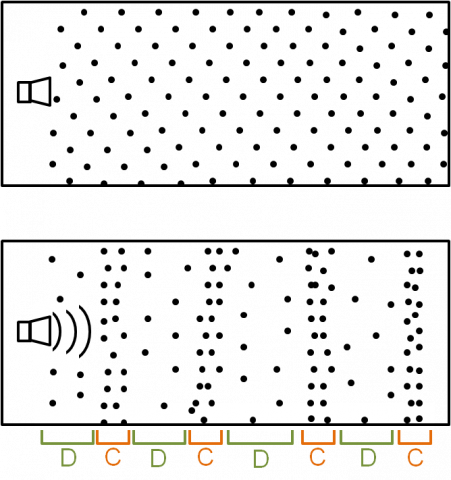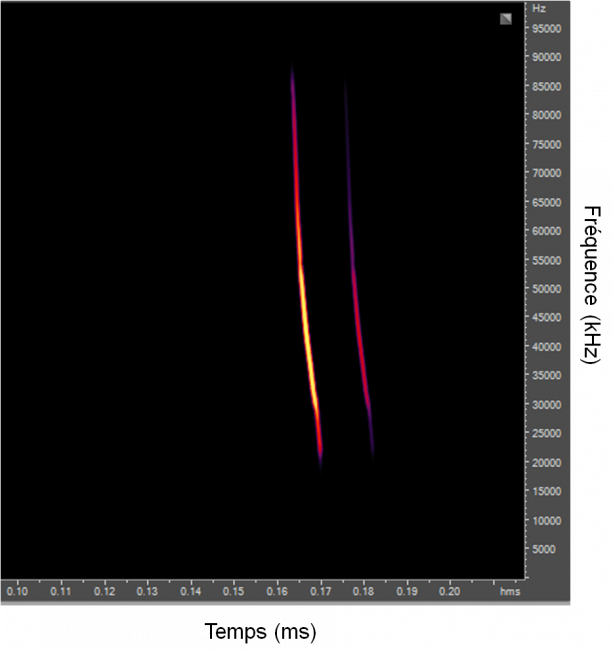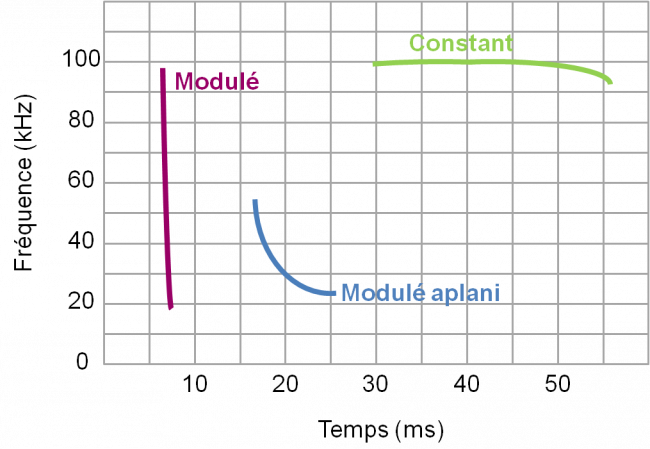Echolocation and sonograms
Bats are usually only seen as quick shadows at dusk. So how can we identify them so that we can study them? We will be able to use a very special feature of bats: their calls.
Echolocation
Bats use their hearing to find their way at night or at dusk. This ability is called echolocation. This system is similar to radar: bats emit sounds that are reflected back by the objects around them in the form of an echo. From this echo that they hear, bats can create a mental image of their surroundings.
The sounds used by bats are ultrasonic, i.e. they are too high-pitched for the human ear to hear. Echolocation requires a very powerful listening system. Bats have very large ears in proportion to the size of their heads.
Echolocation also requires the ability to emit very powerful ultrasound in a very precise manner, which is very energy-intensive. In hunting flight, bats emit ultrasound in synchrony with their wingbeats, which saves energy; they therefore emit at regular intervals. When they have spotted an insect, they emit more rapidly and in the direction of the prey, which allows them to "see" it more precisely. Conversely, when they are travelling over known ground, for example when leaving their nest, they do not emit with every wing beat but rather once every two or three beats.
Les cris sociaux des chauve-souris
Les ultrasons émis pour l’écholocation ne sont pas les seuls sons produits par les chauves-souris, elles émettent également des sons audibles mais extrêmement aigus qui leur servent à communiquer entre elles, on parle alors de cris sociaux.
See ... an inaudible sound
Sound is a wave that propagates in a fluid (air, water, etc.), i.e. a vibration of this fluid: the particles move towards each other and away from each other. Our ears and those of other animals are able to perceive these vibrations. The frequency, expressed in hertz (Hz) of a sound corresponds to the speed at which the particles in the medium move towards and away from each other.
The human ear is able to hear sounds between 16 Hz and 20 kHz, below 16 Hz the sounds are called infrasound and above 20 kHz they are ultrasound. European bats emit between 10 and 110 kHz but mainly above 18 kHz, so their calls are mostly inaudible to humans.
It is possible to 'hear' recorded bat calls by playing them in slow motion. By slowing them down, it is as if the vibration is slower, the frequency of the sound decreases and becomes audible!
A sound can be represented visually in the form of a sonogram, which is a graph representing the frequency of the sound as a function of time. The intensity of the sound can also be represented; if it is louder or softer, by a colour or grey gradient on the sonogram. Depending on the shape of the sonogram and the frequency of the calls, it is possible to distinguish one species from another. However, there are some very similar species that are difficult to recognise, so they can be grouped together in species groups.
Listening to a Bat :
Some basics for identification from sonograms
Bats produce three main types of ultrasonic signals:
- modulated signals: the call rises or falls in frequency very rapidly
- constant signals: the call maintains almost the same frequency throughout its length
- flattened modulated signals: the call drops in frequency rapidly and then remains at a constant frequency for a few milliseconds.
The shape of the signal can be used to distinguish groups of bat species: Rhinolophs produce constant signals, Pipistrelles and Noctules flattened modulated signals and Murins modulated signals.
The different species can be distinguished on the basis of the frequency or range of frequencies at which the calls are made. For flattened modulated signals, the frequency at which the signal flattens out is called the terminal frequency and is also used for species identification.



